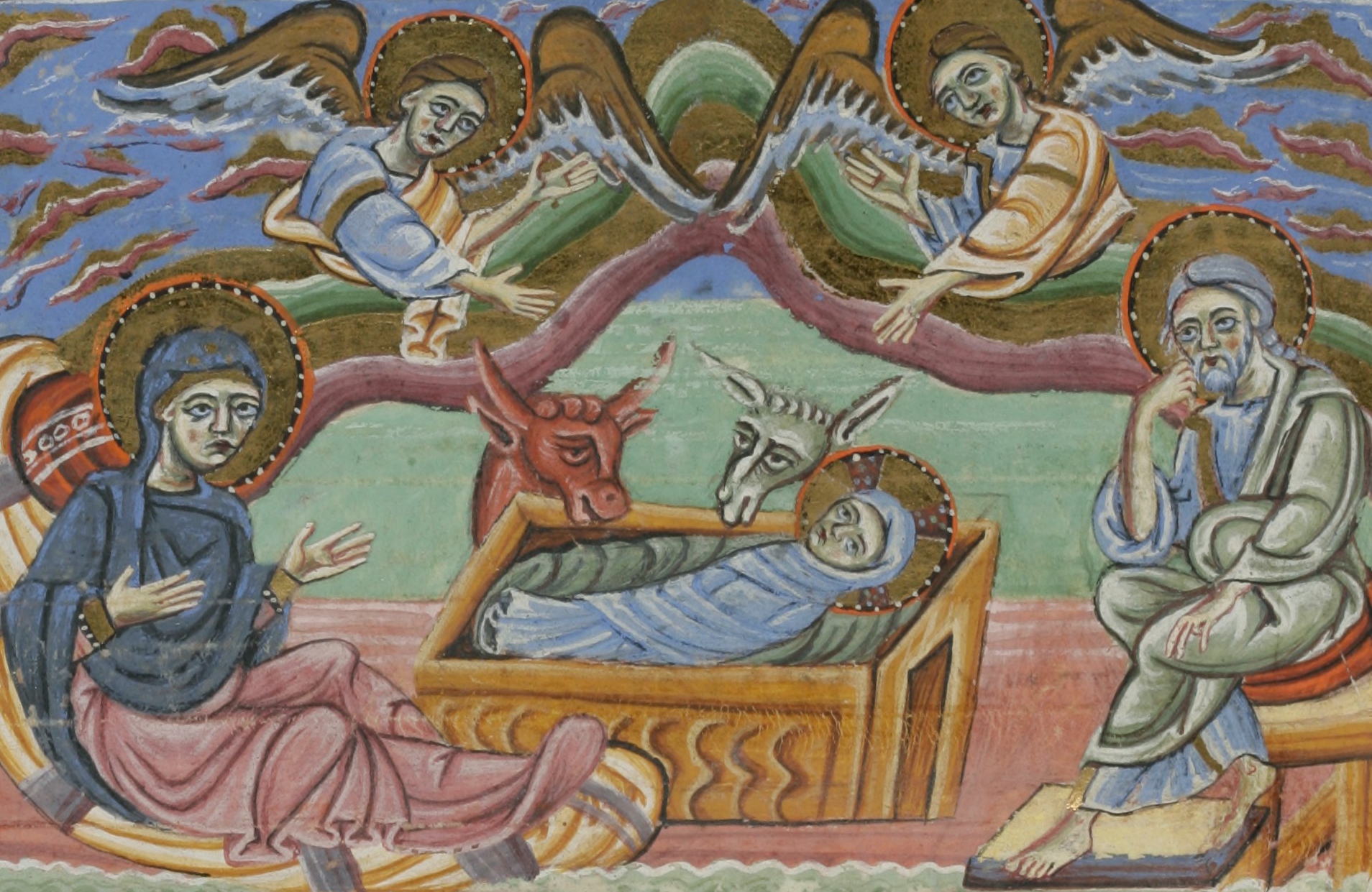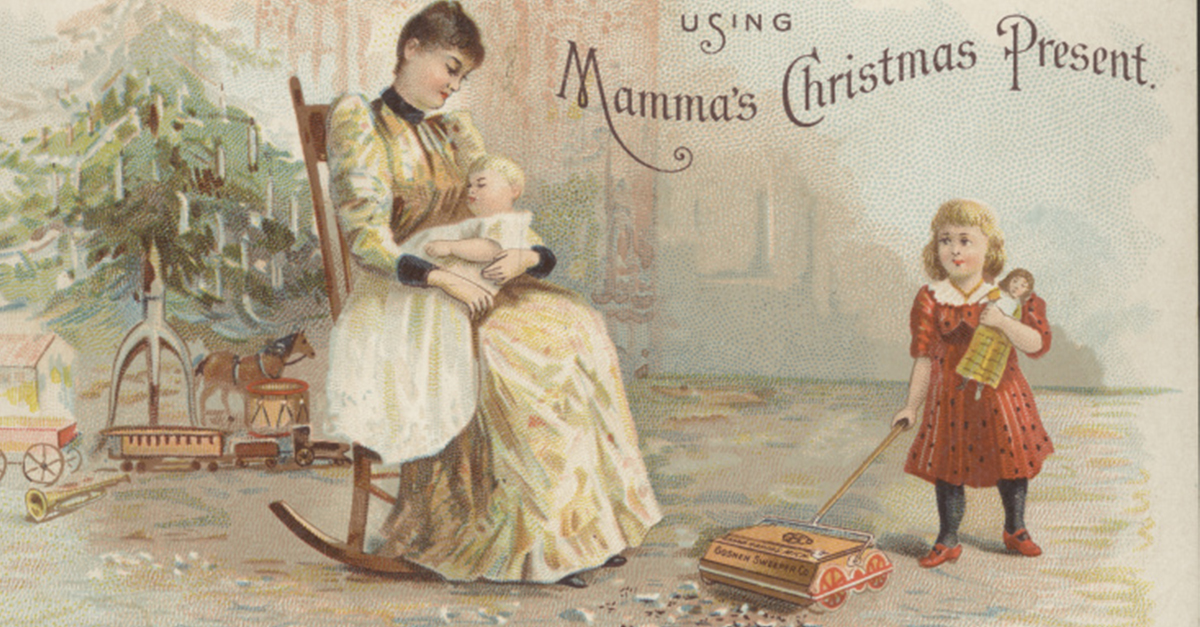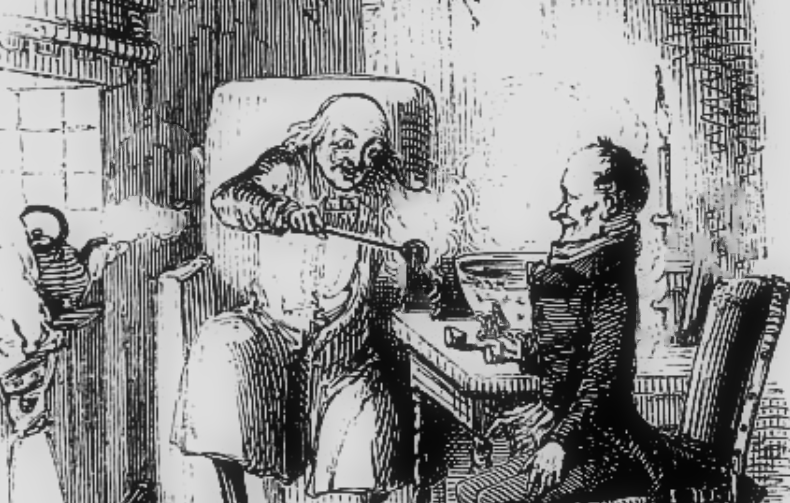The Most Wonderful Time Of The Year
It’s the source of hundreds of cheery songs and thousands of hours of stressed parents. When the snow is flying and the days are dark early, many families gather together and celebrate, and they have been for centuries. But Christmas didn't always look like it does today. In fact, it used to be much different. Let's take a look.
It Wasn’t Always Christmas
The holiday we know as Christmas celebrates the birth of Christ, hence the name. But the tradition of celebrating a mid-winter festival predates the birth of Christ by many centuries. In fact, our modern conception of the holiday really only came about in the mid-to-late 1800s.
Ancient Rome
Christianity was just getting started during the time of the ancient Romans. As the religion gained popularity and power, many Roman Emperors converted to Christianity. But before this, Roman citizens first experienced quite a different "Christmas" celebration.
 John Reinhard Weguelin, Wikimedia Commons
John Reinhard Weguelin, Wikimedia Commons
Saturnalia
One pagan Christmas precursor was a festival called Saturnalia. This week-long festival celebrated Saturn, ruler of the Roman gods, and took place between the 17th and 23rd of December. The festival dates back to about 500 years before the birth of Christ.
 Themadchopper, Antoine-François Callet, CC0, Wikimedia Commons
Themadchopper, Antoine-François Callet, CC0, Wikimedia Commons
“The Best Of Times”
Roman poet Catullus called Saturnalia “the best of times”. The festival celebrated Saturn’s rule during a time that many felt was a prosperous and happy time for the empire. Both the Winter Solstice and Saturn’s characterization as an agricultural god played a role in the celebrations.
Familiar Practices
The Saturnalia festival was a gift-giving event where families and friends would gather together and share feasts and play games. Some things often frowned upon in polite society became more acceptable as citizens celebrated their bounty and the promise of a prosperous new year.
 Fototeca Storica Nazionale, Getty Images
Fototeca Storica Nazionale, Getty Images
Things Change
With the movement in Ancient Rome toward Christianity, many pagan sites and temples were closed, and rituals and events celebrating the pagan gods were prohibited. The traditions of Saturnalia were, however, very popular with Romans, so many of them became associated with Christmas.
 Antoine Caron, Wikimedia Commons
Antoine Caron, Wikimedia Commons
Medieval Times
A few hundred years later, Christmas was still an important part of Christian life. The holiday was celebrated for 12 days, which is where we get the popular Christmas song “The Twelve Days of Christmas”. Medieval Christmas began on the December 24th and concluded on January 5th.
The Pagans Aren’t Completely Gone
Among the traditional decorations for Christmas, both now and in medieval times, were winter plants like holly, ivy, and mistletoe. These plants had long been collected and revered by the ancient Celts, and decorating a home with garlands of these plants was thought to ward off evil spirits.
 Trish Steel, CC BY-SA 2.0, Wikimedia Commons
Trish Steel, CC BY-SA 2.0, Wikimedia Commons

History's most fascinating stories and darkest secrets, delivered to your inbox daily.
Kissing Under The Mistletoe
Our modern wreaths come from the practice of having a large hoop of mistletoe prominently displayed in medieval homes. Mistletoe was thought to promote fertility by ancient pagans. From this belief, we gain our tradition of kissing under the mistletoe.
 Wellcome Images, CC BY 4.0, Wikimedia Commons
Wellcome Images, CC BY 4.0, Wikimedia Commons
Heading To Church
Celebrating the birth of Christ was, of course, the central aspect of Christmas for medieval people. Churches would bring out their finest decorations, and attendance at masses was often compulsory. Special songs were also performed by choirs during this time.
 Gerard Horenbout, Alexander & Simon Bening, Wikimedia Commons
Gerard Horenbout, Alexander & Simon Bening, Wikimedia Commons
The Nativity Scene
The practice of acting out the Nativity, the birth of Christ, began in the medieval period. During services, individuals would act out portions of the event, a practice known as “troping”. Troping eventually evolved into a more theatrical production, similar to the Nativity plays with which we are familiar.
 Virtual Manuscript Library of Switzerland, CC BY-SA 2.0, Wikimedia Commons
Virtual Manuscript Library of Switzerland, CC BY-SA 2.0, Wikimedia Commons
The Gifts Keep On Coming
Gifts were an important part of medieval Christmas, symbolizing the gifts of the Magi at the birth of Christ. Rich and poor alike participated in gift-giving. Gifts were also exchanged on January 1st, known as “first gifts”. They often symbolized hopes for good fortune in the coming year.
 Nina-no, CC BY-SA 2.5, Wikimedia Commons
Nina-no, CC BY-SA 2.5, Wikimedia Commons
First-Footers
Much was made of the first guest in a home on New Year’s Day. These guests were called “first-footers”, and what a guest looked like was thought to dictate how a year would progress. Dark-haired, flat-footed men were among the most desirable.
 Philipp Eisenberger der Jüngere, Wikimedia Commons
Philipp Eisenberger der Jüngere, Wikimedia Commons
Food And Entertainment For All
The 12 days of Christmas were considered a time to rest, celebrate, and recuperate from the past year. Feasts, for rich and poor alike, were more elaborate than usual. Churches and guilds provided free entertainments, and parties, especially the final Twelfth Night celebrations, often got out of hand.
 Unknown Author, Wikimedia Commons
Unknown Author, Wikimedia Commons
A Time Of Charity
One aspect of Medieval Christmas that we continue to practice in modern times is of practicing charity toward the less fortunate. Leftovers from grand feasts were often distributed to the poor as a way of demonstrating some of the qualities embodied in Jesus Christ.
 Meester van het Dresdense Gebedenboek, Wikimedia Commons
Meester van het Dresdense Gebedenboek, Wikimedia Commons
The Elizabethan Way
The rule of Queen Elizabeth I is considered one of the most important eras in British history. Many social changes took place during this era, and some of the greatest pieces of literature were produced. Christmas also changed somewhat during this time.
 George Gower, Wikimedia Commons
George Gower, Wikimedia Commons
Not So Much Church
The British Reformation changed the way people thought about churches. Focusing more on the words of the Bible rather than the pomp and circumstance of services, churches became far less flashy and decorative during the Christmas season.
 Giovanni Antonio Canal, Wikimedia Commons
Giovanni Antonio Canal, Wikimedia Commons
The Holy-Day Season
Our modern term “holiday” comes from the idea that most public holidays during the Elizabethan era were religious celebrations, or “holy days”. Despite their connection to religion, more secular traditions began asserting themselves at Christmas time in this period.
 Wellcome Images, CC BY 4.0, Wikimedia Commons
Wellcome Images, CC BY 4.0, Wikimedia Commons
Counting Down From Advent
Our modern tradition of the Advent Calendar comes from the religious holiday of Advent, which began on November 30th. Although it started out as a time of fasting and penitence, Advent evolved into a time marking the countdown to the gifts and food of the Christmas celebrations.
 Special Collections Toronto Public Library, CC BY-SA 2.0, Wikimedia Commons
Special Collections Toronto Public Library, CC BY-SA 2.0, Wikimedia Commons
A Festival Of Feasting
Although gift-giving and charity were still important parts of the Christmas celebrations, food was the one everyone looked forward to. The tradition of Christmas baking became very important in the Elizabethan era, with bakers in homes beginning their preparations well before the big parties of the 25th.
 Pieter Brueghel the Younger, Wikimedia Commons
Pieter Brueghel the Younger, Wikimedia Commons
Meat, Pies, And Wassail
Meats of various kinds were a rarity for the poorer folk during the Elizabethan era, which is why they were a favorite food for Christmas. Various pies and the eternal fruitcake were also present on the table. Wassail, a spiced ale, was popular and was also used to bless trees for a prosperous year to come.
Playing At King And Queen
Spending the day playing games with family and friends was a large part of celebrating Christmas in Elizabethan times. One particular game involved designating two guests “king and queen of the feast”. Allowing commoners to act like royalty was seen as a particularly hilarious game.
Seeing The Sights
Aside from seeing a city dressed up for celebrations, some would take the opportunity of the Christmas break to see various sights of the kingdom. A visit to the crown jewels in London was a popular destination, as was Francis Drake's ship the Golden Hind, the first English boat to sail around the world.
 Mike Peel (www.mikepeel.net)., CC BY-SA 4.0, Wikimedia Commons
Mike Peel (www.mikepeel.net)., CC BY-SA 4.0, Wikimedia Commons
Christmas No More?
The Reformation of the English church did raise some problems for Christmas. The name brought to mind a Catholic mass, which the Anglican nation did not look upon kindly. Further, the more puritanical of the country’s religious people thought Christmas should be a time of fasting and reflection.
Celebrate 1660
After the controversy over the name and practices of Christmas, the holiday was rescued by the passing of a law in 1660. From this time forward, the celebration of Christmas became the most important holiday of the year.
 Josiah King, Wikimedia Commons
Josiah King, Wikimedia Commons
On To The Victorians
During the reign of Queen Victoria from 1837 to 1901, many of the more familiar traditions we associate with Christmas came into being. Looking back on the traditions of the Medieval period, the Victorians ushered in a time of Christmas being a remembrance of the past.
 Heinrich von Angeli, Wikimedia Commons
Heinrich von Angeli, Wikimedia Commons
O, Tannenbaum!
The Prince Consort, Albert of Saxe-Coburg, introduced one of the most famous and enduring Christmas traditions: the Christmas Tree. That's right, before this it wasn't common everywhere to have a Christmas tree.
Queen Victoria’s husband was from modern-day Germany, and the tradition of bringing a tree into the house was popular there.
 Joseph Lionel Williams, Wikimedia Commons
Joseph Lionel Williams, Wikimedia Commons
Just Like The Royals
After Prince Albert began the tradition, having a Christmas tree became a popular practice amongst royals and nobles throughout England. Magazines, much like the ones we have now, that showed off the fabulous lifestyles of the rich then helped the tradition become common practice in all classes of society.
 The Illustrated London News, CC BY 4.0, Wikimedia Commons
The Illustrated London News, CC BY 4.0, Wikimedia Commons
Always Tip Your Caroler
The earliest books of Christmas carols date back to almost the Medieval period, so it’s no surprise that the Victorians brought the tradition of carol singing back to prominence. Small groups would go house to house, singing songs, and hoping for a small drink or pie as payment for the entertainment.
 Nikiforos Lytras, Wikimedia Commons
Nikiforos Lytras, Wikimedia Commons
Christmas Greetings
One significant advancement of the Victorians was establishing a cheap and easy postal system. As a result, it became traditional to send Christmas greetings to friends and family who lived far away. This, of course, became our tradition of sending Christmas cards during the holiday season.
 Miami U. Libraries - Digital Collections, Picryl
Miami U. Libraries - Digital Collections, Picryl
Just Like Now
The Victorian Era began almost 200 years ago, but some things haven’t changed much. Stores would send out colorful catalogs and decorate their windows with extravagant gifts, all in an effort to entice shoppers to part with their hard-earned money.
 Cleveland Museum of Art, Picryl
Cleveland Museum of Art, Picryl
Boxing Day
While presents and celebrations traditionally took place on Christmas Eve and Christmas Day, Boxing Day, December 26th, became an important part of the tradition too. It was on this day that, much like their Medieval forebears, employers would give boxes of small gifts and leftovers to their employees.
The Coming Of Father Christmas
Whether you call him Santa Claus or Father Christmas or Christkind, the jolliest of gift-giving traditions is St Nick. Father Christmas has his origins in the 4th Century Saint Nicholas, Bishop of Myra. The original St Nicholas enjoyed giving gifts.
 Jean Bourdichon, Wikimedia Commons
Jean Bourdichon, Wikimedia Commons
The Jolly Old Elf
The Victorian take on Father Christmas incorporated much folklore, keeping in touch with some of the pagan origins of the holiday. The familiar red-suited version of Santa Claus came into existence around 1850, and the rest is history.
It’s Still About The Food
One obvious throughline in the history of Christmas is the association of feasting and food. Living standards were slightly higher during the Victorian Era than in times before, so many would splurge on expensive and rare meats for their Christmas dinner table.
A Different Kind Of Carol
The late Victorian Era gave Christmas one of its more enduring stories: A Christmas Carol. Charles Dickens's tale of Ebenezer Scrooge and his visits with Christmas ghosts has become emblematic of the spirit of charity and forgiveness associated with the holiday season.
 Francis Alexander, Wikimedia Commons
Francis Alexander, Wikimedia Commons
Just Like Scrooge Said!
Early in the era, roast beef and goose were popular Christmas meats. As the decades drew on, turkey became the go-to treat for dinner tables, leading to Dickens’s famous ending of A Christmas Carol in which Scrooge gifts his employee Bob Cratchit with a huge turkey.
A Cracking Celebration!
Another tradition from the Victorian Era is Christmas crackers. These tubes of paper often contain party hats, gifts, and jokes, and are pulled apart at the dinner table. The inclusion of small strips of combustible material makes the crackers bang apart, hence the name.
 Norman Rockwell, Wikimedia Commons
Norman Rockwell, Wikimedia Commons
Into The Present (Pun Intended!)
While many Christmas traditions were indeed products of their time, there are certainly many that have stayed with us through the centuries. Even in the 20th Century and beyond, Christmas traditions, like meeting Santa at the mall, will likely continue for years to come as part of the joyous Christmas season.
 Donald Trung Quoc Don (Chữ Hán: 徵國單), CC BY-SA 4.0, Wikimedia Commons
Donald Trung Quoc Don (Chữ Hán: 徵國單), CC BY-SA 4.0, Wikimedia Commons




















